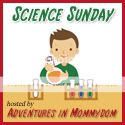We are continuing our ocean study and did a fun sink or float ocean experiment today.
We hypothesized if it is easier to float in the ocean or in a swimming pool/lake? And why?
To test this hypothesis we filled one container with tap water (1.5 cups). In the second container, we added 1/3 cup salt to 1.5 cups water to make our salt water. Stir until all the salt is gone. I explained that the salt water is like the water in the ocean. We talked about how "salt gets in the ocean". One way is through rivers, which run over rocks containing salt and then carry it into the ocean. Another way is through volcanoes, erupting under water and releasing salt into the water.
Smiley sampled from both containers to make sure one was saltier ;)
Smiley then predicted what will happen when we put an egg in each glass...
We added a raw egg to each container.
We talked about why the egg floated in the salt water, but not in the fresh water... Salt water is denser than fresh water; therefore, an egg will sink in fresh water because the egg is heavier than the fresh water. However, the egg will float in salt water because the egg is lighter than the salt water.
In the end, you can slowly pour the fresh water into the glass with the salt water and floating egg. The egg should be floating in the middle of the cup. The fresh water is lighter than the salt water, so it should float on top of the salt water. I had Smiley pour the water in and I think he poured it too fast, causing all the water to mix together and this part therefore didn't work as nicely for us...
I got this idea from homeschool share, where this Float or Sink is part of their Hello Ocean Lapbook.
They have a fun little lap book component to go with this experiment that you can do with your child after doing the experiment :)












We did a sink or float activity this week too, this would be a great extension to what we already did with basic sink and float! Thank you for sharing :)
ReplyDeleteThat is such a fun experiment for kids. Thanks for linking up!
ReplyDelete